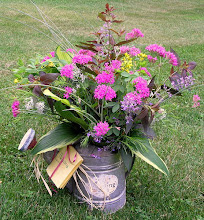 Many times people ask me if they can divide newly purchased plants. The answer is "yes" in some cases and "no" in other cases. Sempervivums (hens and chicks) like you see here in this photo are easy to divide. To read more about this specific case, click on Old Country Gardens and you'll see what I did with these new babies.
Many times people ask me if they can divide newly purchased plants. The answer is "yes" in some cases and "no" in other cases. Sempervivums (hens and chicks) like you see here in this photo are easy to divide. To read more about this specific case, click on Old Country Gardens and you'll see what I did with these new babies. Some plants aren't as easy to divide. This newly purchased Symphytum was just exploding out of the pot but it didn't look like it had an easy place to cut it apart so I planted it whole.
Some plants aren't as easy to divide. This newly purchased Symphytum was just exploding out of the pot but it didn't look like it had an easy place to cut it apart so I planted it whole. With this pot of Astilbe I tried an experiment and took a sharp knife and cut it right down the middle. Both divisions grew just fine. One tip I can give you is that this plant was not yet blooming or in bud while the Symphytum in the previous photo was in bloom. I'd be less likely to cut apart a plant in bloom unless I was willing to also cut off all the blooms.
With this pot of Astilbe I tried an experiment and took a sharp knife and cut it right down the middle. Both divisions grew just fine. One tip I can give you is that this plant was not yet blooming or in bud while the Symphytum in the previous photo was in bloom. I'd be less likely to cut apart a plant in bloom unless I was willing to also cut off all the blooms. Hosta are one of the plants that you can divide most times during their growing season. Just take care to water your new divisions well, especially if you've planted them in a spot where they are going to get a few hours of direct sun.
Hosta are one of the plants that you can divide most times during their growing season. Just take care to water your new divisions well, especially if you've planted them in a spot where they are going to get a few hours of direct sun. Daylilies can be divided just about any time too. I've been to many a daylily nursery where they've dug out a fully blooming plant like this 'Monterrey Jack' and just handed it to me. The right thing to do is to cut back the foliage and bloom scapes but I've even planted them with the blooms and they've done just fine. Again, you need to give it a little extra care until it's settled in but in the long run it was worth the extra work.
Daylilies can be divided just about any time too. I've been to many a daylily nursery where they've dug out a fully blooming plant like this 'Monterrey Jack' and just handed it to me. The right thing to do is to cut back the foliage and bloom scapes but I've even planted them with the blooms and they've done just fine. Again, you need to give it a little extra care until it's settled in but in the long run it was worth the extra work.This works especially well if you are buying pots chock full of little 'Stella D'Oro' and want to divide it before planting.
This summer I'll have the garden open during daylily season which is the month of July here on Long Island. While I won't dig every single plant in the garden, I will be willing to dig many of the clumps that are here if they are in a spot that is accessable.
We'll be open this weekend as usual on Saturday, May 30th. We usually put our sign out around 10:00 am and stay open until 4:00 pm. We have lots of new Hosta for you to buy along with the ferns, and sun perennials. If the weather allows, I'll be digging up that 'Monterrey Jack' daylily and potting that up too.



















































